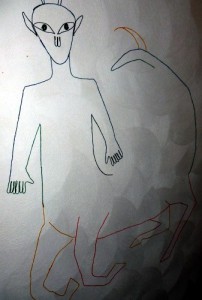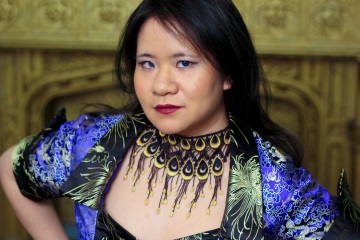Breaking Mirrors – Diana Pho
I think Diana Pho’s post makes a good follow-up to Isabel Schechter’s post yesterday, though I’m having a little trouble getting the words right to explain why. (Low blood sugar incident last night means a very sleepy and brain-fuzzed Jim today.) Both Pho and Schechter talk about the difficulty they’ve had in finding themselves reflected in SF/F. Schechter described how important it was to finally find a good Puerto Rican character, and her fear and anger that Hollywood might take that away from her. Pho talks about finding herself by pulling different pieces from different stories.
It also ties in to some of what S. L. Huang said about intersectionality. I love the way these individual guest posts overlap and work together to (hopefully) build a deeper understanding…
Junot Diaz—rightly so—gets quoted often in the representation convo. One of his truth bombs stuck with me:
“You know, vampires have no reflections in a mirror? And what I’ve always thought isn’t that monsters don’t have reflections in a mirror. It’s that if you want to make a human being into a monster, deny them, at the cultural level, any reflection of themselves. And growing up, I felt like a monster in some ways. I didn’t see myself reflected at all.”
But here’s another truth valid in my life: when I didn’t see myself in a mirror, I smashed it and saw myself in the pieces.
#
The libraries I frequented growing up sorted their children sections in alphabetical order. Often, I choose new authors based on the jacket cover. Two things on one particular cover caught my eye: a wolf pack and a girl who shared my brown almond-shaped eyes and olive skin. At nine-years old, I fell in love with Julie of the Wolves by Jean Craighead George.
Mind you, I’m not Native American. But Julie was the first time I ever saw anyone who even looked remotely like me on a book and she got to befriend wolves. How cool was that?
I wanted Julie to be my friend to bond over specific things. She had two names like me—her American name and her Native one, Miyax (I also had an American name and Vietnamese name). She survived the Arctic tundra (I had New England winters!). She learned how to cook caribou stew that her lupine friends regurgitated for her after their kills (my mom’s curries could be made from caribou meat if I ate with my eyes closed).
Julie of the Wolves led to a lifelong interest in wolves and Native American cultures. But it was through my later studies I learned how George, a white woman, had conflated Yupik and Inupiaq cultures and how she refused to correct her mistakes in later sequels. The book also contains a lot of negative portrayals of Native culture and blatant stereotypes. I understand now how damaging these aspects are to the Inquiaq community, especially since this Newberry Award-winning book is still widely read in schools today.
But back then I pocketed a mirror shard to treasure: it wasn’t weird to live between two cultures. I wasn’t the only one who had to explain aspects of my family life to my white friends or have them make assumptions about who I was because of where my parents came from. I could be Diana and Tâm just as she was Julie and Miyax.
#
A couple years later I picked up a team of new book friends: the Animorphs, which was also my introduction to sci-fi and to fandom.
 As scary as being child soldier fighting a secret alien invasion was, I wished to be an Animorph. I knew exactly who I’d be like: Cassie, the black girl whose parents were vets and had a whole barn full of animals. She was the compassionate, sensitive one, the group’s moral compass; I saw my own personality in her. But she was only my second favorite; my first was Aximili-Esgarrouth-Isthill, the Andalite prince, the outsider from another world stuck on Earth.
As scary as being child soldier fighting a secret alien invasion was, I wished to be an Animorph. I knew exactly who I’d be like: Cassie, the black girl whose parents were vets and had a whole barn full of animals. She was the compassionate, sensitive one, the group’s moral compass; I saw my own personality in her. But she was only my second favorite; my first was Aximili-Esgarrouth-Isthill, the Andalite prince, the outsider from another world stuck on Earth.
Ax’s blatant missteps about American pop culture, his awkwardness, and his loneliness pulled at me viscerally. My first fanfics were about Ax and his honor-bound homeworld. My sister and I even drew a picture of Ax made of flexible wax sticks on our shared bedroom ceiling. Ax stayed there until my parents pulled it down last year when they were preparing to sell the house. At night, trotting among the glow-in-the-dark stars, Ax stood guard as I imagined stories about my alien friend, someone who could understand what it felt like not to fit into the rest of human society, even when he had the Andalite technology to look exactly like them.
Both of us had our human shells, Ax and I.
#
For one golden moment on American TV, I did see a character that surprised even me: Tina Nguyen from the PBS show Ghostwriter. She was the first Vietnamese girl I saw on TV that wasn’t a variety performer from one of my parents’ Paris by Night videocassettes or a barefoot villager running from/shooting at American soldiers in a sweltering jungle.
Her family’s story was not my family’s story. We had different hobbies (hers videography; mine writing and drawing), different home lives (she was from Brooklyn; her family owned a store; mine were suburban, my parents a nurse and an electrical engineer). She had a group of friends who all saw a ghost who traveled through the wires of the Internet and used the written word to communicate. Together, they solved mysteries around Brooklyn.
There were storylines that struck home. In one episode, Tina broke her mother’s favorite flower vase, and her mother was sad because those flowers reminded her of the village she left behind. Tina searched the city and found a branch of living blooms to give her in apology. I saw my own mother’s wistfulness and sadness in hers. But, like from all of the other characters I had corralled as a part of me, I took the pieces I needed. Seeing Tina there finally filled in that gap I knew I had been missing.
That was how I learned to survive; by seeing myself in the pieces I could, even if I didn’t exactly, see me. My list of favs I identified with one way or another grew over time. Demona from Gargoyles. Louis de Pointe du Lac of the Vampire Chronicles. Remus Lupin from Harry Potter. The loners and the outsiders. Bitter or resolute and loyal. Human to the core, despite the differences on the surface.
In the end, what did I do with these pieces? In one sense, I made a funhouse mirror to view myself—distorted, warped, imperfect, but nonetheless mine. On the other hand, funhouse mirrors are whole. A better word, perhaps, would be a mosaic. Or a stained glass window—one I needed that impacted my viewpoint of the world.
A common misconception about diverse representation is that its effects are, at best, liminal. Representation can only fit in the frameworks of “good” or “bad” examples. In reality, representation is more like constructing your fancy glass houses, then letting everyone else smash them apart and pick up bits to take home. Your art can easily cut others deeply, resulting in infection and scars. People may step around the broken fragments to protect themselves, or gather them carefully with padded gloves. And, on occasion, someone may pick out a shard from the dirt because it had sparkled like a jewel in their hand.
I want to see the landscape of science fiction and fantasy to become a city of reflections, blatant and elusive. I want so many examples that we can point to the variety and note the great and the terrible and the in-between without the fear of pointing out the fractures. The marginalized shouldn’t be feel like they are trapped inside the gilded frame of diversity nor should they be denied the ability of tell their own stories. Stories about the marginalized shouldn’t be lifted by the privileged to profit from that exposure, either.
The purpose of representation isn’t only about white, straight, cis folk relating to the “Other”. It is about me, a queer Asian-American woman, relating to you, who is black (and/or Muslim and/or trans and/or deaf and/or, and/or…). Representation should be a network of connections, not a single link between a minority exception and a standardized whole.
So let’s acknowledge what diverse storytelling actually is: building our own little stained-glass-mirrors out of other people’s stained-glass-mirrors. We hold up our respective mirrors between us. In that space glints refracted color and pure transparency and the glow of our faces—that is the impact of representation.
Diana M. Pho is an editor at Tor Books and blogs for Tor.com. She is also a published scholar, activist, performer, and general rabble-rouser. She is best-known for running Beyond Victoriana, an award-winning, US-based blog on multicultural steampunk under the moniker Ay-leen the Peacemaker. For several years, she has traveled the country as a professional convention speaker about social justice issues and fandom. Her most recent publications include the introduction to The Best of Spanish Steampunk, edited by James and Marian Womack and she has a forthcoming article in Like Clockwork, edited by Professors Brian Croxall and Rachel Bowser. You can follow her on Tumblr and Twitter.







Diana M. Pho
March 13, 2015 @ 10:22 am
I’m so happy to be a part of this blog series. Thanks, Jim!
“Breaking Mirrors” — Guest post on Jim C. Hines’s Blog | Beyond Victoriana
March 13, 2015 @ 10:32 am
[…] Read the rest of the post here. […]
celli
March 13, 2015 @ 12:24 pm
Such a great read! And I have many good memories of Ghostwriter. 🙂
Diana M. Pho
March 13, 2015 @ 12:56 pm
Thanks, celli! PBS is a godsend, actually. I didn’t grow up with cable, and I loved so many of the shows I found there.
A. Pendragyn
March 13, 2015 @ 1:04 pm
Beautiful imagery. Thanks for writing this.
Tamora Pierce
March 13, 2015 @ 1:34 pm
Thank you for this. It gives me plenty to reflect on.
Diana M. Pho
March 14, 2015 @ 2:55 pm
Thanks for reading. ^^
Diana M. Pho
March 14, 2015 @ 2:56 pm
I’m glad you enjoyed it. I was trying to fit in a lot of different thoughts I had about representation in a concise manner and I’d be interested in seeing what “pieces” people take away from this.
In Conversation with… Emmie Mears! | Graham's Crackers
March 27, 2015 @ 1:36 pm
[…] man of color? If you see yourself at all, you are conditioned to scramble to pick up the scraps. Diana Pho (editor at Tor) wrote a phenomenal piece on Jim Hine’s blog recently. Go read it. I’ll […]
anglerfish07
April 15, 2015 @ 6:06 am
Thank you for this great article! Definitely food for thought, and the part on finding yourself in different pieces struck a chord with me. 🙂